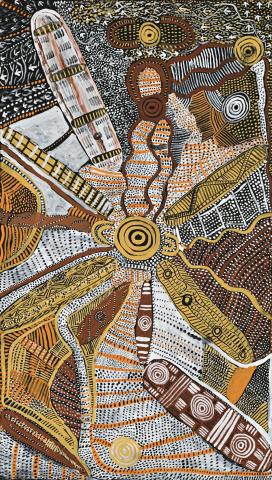WATER DREAMING AT KALIPINYA, 1972
Johnny Warangkula Tjupurrula
synthetic polymer powder paint on board
64.0 x 36.5 cm
Acquired by Geoffrey Bardon at Papunya in 1972 Mrs L. Bardon, New South Wales Sotheby's, Melbourne, 9 July 2001, lot 74 Private collection, Melbourne
Bardon, G. and J. Bardon, Papunya, A Place Made After The Story, The Beginnings of the Western Desert Painting Movement, The Miegunyah Press, Melbourne University Publishing, 2004, p. 275 (illus. as painting 206)
For a discussion of the Water Dreamings theme see Bardon and Bardon, 2004, p. 49 and for further discussion on the artist and the Water Dreamings see ibid p. 157 and p. 61 (Map 8) for a detailed map of the artist's country (homeland).
In his book Papunya Tula Art: of the Western Desert, Geoffrey Bardon describes the painting of Johnny Warangkula as 'of major significance, they are strictly Aboriginal stories without conscious European influence and yet they can be measured by the modern Aesthetic... his work has anecdotal intimacy, a candid freshness and spontaneity that beguiles by its individuality.'1 Portrayed by Bardon as a happy, expressive man who was a tireless worker, Johnny Warangkula Tjupurrula is credited with developing a dotting method that was particularly admired and was later adopted by other painters becoming the convention for Western desert painting. Bardon described this style as 'tremulous illusion' where overlays of stippling and dotting gives the paintings a three-dimensional quality.2
The most absorbing interest in Warangkula's art was the Water Dreaming. His intricate depictions of the permanent soak of Kalipinypa or the waterholes of Tjikari and Ilpili display a determination to paint the complexity of his country, his heritage.
Representing the activities of the Waterman ancestor at the site of Kalipynipa, our painting is characteristic of the complexity of Tjupurrula's work. Easily read as a map of country depicting water courses, vegetation and birdlife, the painting also illustrates white egrets and the response of birdlife to rain, travelling vast distances as the seasons change. The arrow shapes at the base of the painting show footprints of the Egret ancestor, the 'U' shape are the seated ceremonial Watermen, the wavering lines are running water and varied linear and dotted backgrounds are differing types of vegetation (bush tucker). John Kean credited Tjupurrula with discovering the use of dots to illustrate vegetation. The dominant ovoid forms represent Tjuringa (sacred objects) and the central roundel the ceremonial site for the activities of the Watermen and the Egret ancestors.
1. Bardon, G., Papunya Tula: Art of the Western Desert, Penguin Books, Melbourne, 1991, p. 53
2. ibid. p. 157
